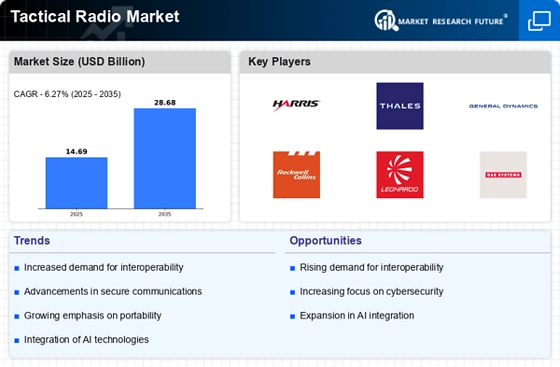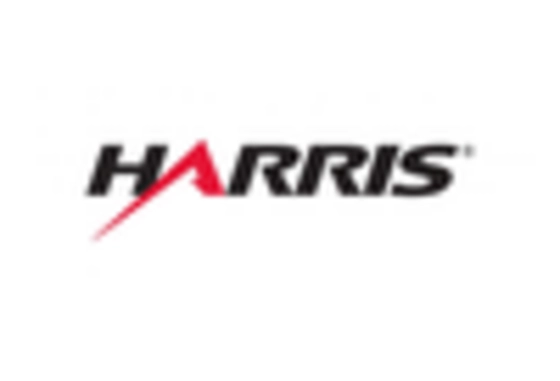Technological Advancements in Radio Systems
Technological advancements play a pivotal role in shaping the Tactical Radio Market. Innovations such as software-defined radios (SDRs) are revolutionizing communication capabilities by allowing for greater flexibility and adaptability in various operational scenarios. These systems enable users to switch frequencies and waveforms dynamically, thereby enhancing interoperability among different military branches and allied forces. The integration of artificial intelligence and machine learning into tactical radios is also emerging, potentially improving decision-making processes and operational effectiveness. As these technologies continue to evolve, the Tactical Radio Market is expected to expand, with manufacturers focusing on developing next-generation systems that meet the complex demands of modern warfare.
Growing Focus on Secure Communication Solutions
The emphasis on secure communication solutions is a critical driver for the Tactical Radio Market. As military operations become increasingly complex, the need for secure and encrypted communication channels has never been more paramount. Threats from cyber warfare and electronic eavesdropping necessitate the development of tactical radios that incorporate advanced encryption technologies. This focus on security is reflected in the rising investments in secure communication systems, with projections indicating that the market for secure tactical radios could reach several billion dollars within the next few years. As defense forces prioritize the protection of sensitive information, the Tactical Radio Market is likely to see a surge in demand for secure communication solutions.
Emergence of Multi-Channel Communication Systems
The emergence of multi-channel communication systems is reshaping the Tactical Radio Market. These systems allow for simultaneous communication across multiple channels, enhancing operational efficiency and coordination among military units. The ability to communicate on various frequencies without interference is crucial for modern military operations, particularly in joint missions involving multiple branches of the armed forces. Recent analyses suggest that the adoption of multi-channel systems is expected to increase significantly, driven by the need for improved interoperability and collaboration. As military organizations seek to streamline their communication processes, the Tactical Radio Market is likely to benefit from the growing demand for these advanced communication solutions.
Increased Defense Budgets and Military Modernization
The Tactical Radio Market is significantly influenced by increased defense budgets and ongoing military modernization efforts across various nations. Governments are allocating substantial resources to enhance their military capabilities, which includes upgrading communication systems. This trend is particularly evident in regions where geopolitical tensions are rising, prompting nations to invest in advanced tactical communication solutions. For instance, recent reports indicate that defense spending in several countries has risen by over 10% in the past year, with a considerable portion directed towards modernizing communication infrastructure. Consequently, the Tactical Radio Market is poised for growth as defense contractors respond to these demands by developing innovative and robust radio systems.
Rising Demand for Enhanced Communication Capabilities
The Tactical Radio Market is experiencing a notable surge in demand for enhanced communication capabilities. Military and defense sectors are increasingly prioritizing advanced communication systems that ensure seamless connectivity in diverse operational environments. This demand is driven by the need for real-time data sharing and situational awareness among troops. According to recent estimates, the tactical radio market is projected to grow at a compound annual growth rate of approximately 7.5% over the next five years. This growth is indicative of the increasing reliance on sophisticated communication technologies to support mission-critical operations. As nations invest in modernizing their armed forces, the Tactical Radio Market is likely to witness further expansion, with a focus on integrating cutting-edge technologies that enhance operational efficiency.

















Leave a Comment